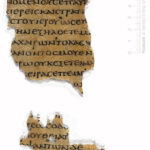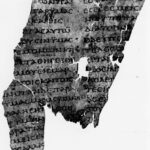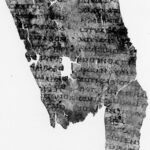| Artefact ID | 702 |
| TM ID | TM 61828 |
| Findspot (DEChriM ID) | 30 (al-Ašmūnayn) | Class | Textual |
| Material | Parchment |
| Writing medium | Codex |
| Text content | Literary |
| Language | Greek |
| Description | Gregory-Aland 0171; Uncial 0171; PSI I 2 + PSI II 124 Parts of two parchment folios from a codex containing Matt. 10:17-23 and 25-32, as well as Luke 22:44-56 (verse 51 was omitted) and 61-64. The small group of parchment fragments constitute 2 folios from a codex containing the gospels of Matthew and Luke. The text is arranged in two columns per page, with an estimate of originally 23 lines of text per column. The Berlin-fragment (P.Berol. inv. 11863) measures 9.2 x 5.7 cm, and preserves 17 (col. i) and 13 (col. ii) lines of text on the recto (hair-side), and 14 (col. i) and 17 (col. ii) lines of text on the verso (flesh-side). The folio preserves Matt. 10:17-23 (recto) and 25-32 (verso). According to K. Treu, Matt. 10:33 has been added in a second hand (narrow script, and less careful) above col. ii on the verso. Its omission is explained as due to a homoioteleuton; see Treu (1966): 26. K. Treu also describes the hand as a small, upright and rounded majuscule, and places it in the 3rd c. The script has also been described as a reformed documentary hand; see Comfort / Barrett 1999: 635-641. PSI I 2 was joined to another fragment, and republished as PSI II 124. The fragments constitute a folio preserving parts of the Gospel of Luke. The fragments measure 4.5 x 7.5 cm (fr. A; PSI I 2) and 5.2 x 5 cm (fr. B). The combined fragments would constitute a folio of approx. 15 x 11 cm with 24 lines per column. The fragment preserves Luke 22:44-50 on the recto and 22:50-56, 61-64 on the verso. Verse 51 and 61 appear to be omitted, and the ed. pr. suggests that the former was intentionally omitted on account of parts of the Gospel being perceived as a gloss; see also ref. ed. The text contains diaereses, several nomina sacra as well as abbreviation of line-end nu. Judging by the content and variants, the codex appears to belong to the Western tradition. |
| Selection criteria | Literary genre (Biblical), Nomina sacra |
| Date from | 175 |
| Date to | 225 |
| Dating criteria | Palaeography. The ed. pr. placed the hand of PSI II 124 in the 4th c., whilst K. Treu placed the fragment of P.Berol. inv. 11863 in the 3rd c.; see Treu (1966): 25-26. The fragment was later assessed as belonging to the late 2nd c. (see Crisci 1998: 105-106), which was accepted, and expanded to include the early 3rd c., by W. Clarysse and P. Orsini; see Clarysse / Orsini (2012): 458 and 472. |
| Absolute/relative date | Relative date |
| Archaeological context | The fragments constituting PSI II 124 were excavated in 1903-1905 in al-Ašmūnayn, while the Berlin fragments (P.Berol. inv. 11863) were acquired in al-Ašmūnayn by Friedrich Zucker in 1910. |
| Accession number | Berlin, Staatliche Museen, Ägyptisches Museum und Papyrussammlung P. 11863 (from where it has been missing since 1990; see BerlPap) + Florence, Biblioteca Medicea Laurenziana 10004. |
ARTEFACT IDENTIFIERS
Reference edition:
∙ Pistelli, Ermenegildo, ed. 1913. Papiri greci e latini II. Florence. 22-25, papyrus no. 124.
Editio princeps:
∙ Pistelli, Ermenegildo. 1912. Papiri greci e latini I. Florence. 2-4, papyrus no. 2 and plate no. 1.
Additional bibliography:
∙ Aland, Kurt. 1987. “Alter und Entstehung des D-Textes im Neuen Testament. Betrachtungen zu P69 und 0171”. Miscel-lània Papirològica Ramon Roca-Puig en el seu vuitante Aniversari Barcelona. 37-61.
∙ Birdsall, James Neville. 2006. "A Fresh Examination of the Fragments of the Gospel of St. Luke in MS. 0171 and an Attempted Reconstruction with Special Reference to the Recto". Collected papers in Greek and Georgian Textual Criticism, Texts and Studies 3. Gorgias Press. 15–138.
∙ Charlesworth, S. d. 2016. Early Christian Gospels: their Production and Transmission. Pap.Flor. XLVII. Firenze. 75-78 and 118.
∙ Comfort, Philip W. and David P. Barrett. 1999. The complete text of the earliest New Testament manuscripts. Grand Rapids, Michigan. 635-641.
∙ Crisci, Eduardo. 1998. “Scrivere libri e documenti nel modo antico. Mostra di Papiri della Biblioteca medicea Laurenziana 25 agosto – 25 settembre 1998”. Pap.Flor. 30 (24). Cavallo, G, E. Crisci, G. Messeri, and R. Pintaudi, eds. 105-106 and plate no. 20.
∙ Jaroš, Karl. 2006. Das Neue Testament nach den ältesten griechischen Handschriften (CD-Rom). Wien-Würzburg: Echter. 3825-3842, no. 2.14.
∙ Naldini, Mario. 1965. Documenti dell'Antichità cristiana descr. no. 11 - 12 and plate no. 10.
∙ Min, Kyoung Shik. 2005. Die früheste Überlieferung des Matthäusevangeliums (bis zum 3./4. Jh.), Berlin, Boston: De Gruyter. 253-270.
∙ Pinchard, L. 2019. "L’oncial 0171, témoin-clef du dévelppement du texte néotestamentaire avant le 3e s.: Un point sur Mt 10,17-32" NT 61. 339–366.
∙ Treu, Kurt. 1966. "Neue Berliner Septuagintafragmente". Archiv für Papyrusforschung 18. 25-28.
∙ van Haelst, Joseph. 1976. Catalogue des papyrus littéraires juifs et chrétiens. Paris. Description no. 356.


 Json data
Json data







